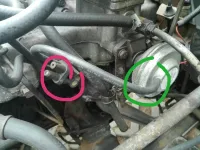Whistling
Scout1067
Old Time Jeeper
I have an odd whistling sound when I get up to operating temperature. At first I thought it was a vacuum leak but I inspected and tested all my vacuum lines and they are good and I am not losing vacuum that I can tell.
I popped the hood and listened this afternoon and the noise is coming from the front of the engine. It almost sounds like it is the water pump. Is it possible that a failing water pump will make a whistling sound? I have not had any problem with overheating. I have the mechanical pump on a straight six.
Last question, I looked at new pumps online and they all ask rotation direction. Is clockwise or counterclockwise determined looking at the front or as I am sitting in the driver's seat?
Sent from my ALE-L21 using Tapatalk
I popped the hood and listened this afternoon and the noise is coming from the front of the engine. It almost sounds like it is the water pump. Is it possible that a failing water pump will make a whistling sound? I have not had any problem with overheating. I have the mechanical pump on a straight six.
Last question, I looked at new pumps online and they all ask rotation direction. Is clockwise or counterclockwise determined looking at the front or as I am sitting in the driver's seat?
Sent from my ALE-L21 using Tapatalk

